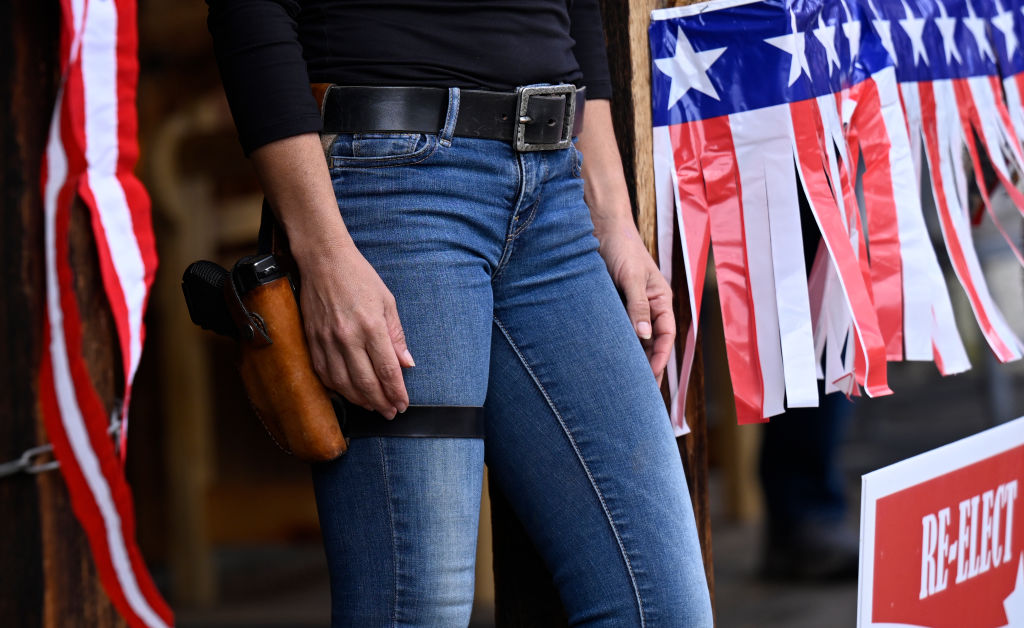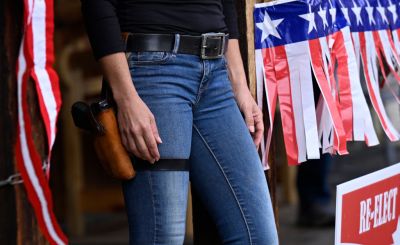Tuesday’s State of the Union was peaceful, but safety concerns prompted a contentious meeting last week in which Republicans quashed Democrats’ push to continue banning firearms in House committee rooms.
The debate and party-line vote came as the Natural Resources Committee decided on its rules for the 118th Congress, which left out a 2021 provision prohibiting members of Congress from bringing firearms into the hearing room.
The same Democrat who raised the debate, Rep. Jared Huffman, and others in his party sent a letter to congressional leadership raising concerns ahead of Tuesday’s State of the Union address and referencing past flaps. In one incident Rep. Andy Harris, a Maryland Republican, set off metal detectors by carrying a concealed gun when trying to go to the House floor.
Debates about members of Congress carrying weapons are nothing new.
What does the law allow?
The People's House used to look more like the Wild West. In the 18th and 19th centuries politicians in both chambers often were armed. Threats of violence and instances of intimidation toward other lawmakers, reporters, and witnesses, were common, according to Joanne B. Freeman, who wrote a book about violence in the Capitol in the lead-up to the Civil War.
Rules around firearms on the Hill have evolved since: Congress passed a law in 1967 prohibiting weapons on U.S. Capitol grounds and its buildings.
The District of Columbia in general has strict gun laws: Among other limitations, D.C. requires all permitted firearms to be registered and makes certain kinds of semi-automatic firearms illegal. The District does not recognize gun permits from other states.
But members of Congress have a carve-out: They can keep firearms in their office but must transport them unloaded and secured .(D.C. law requires transported firearms to be in a locked container and separate from any ammunition.) The limited exception does not include the right to bear a loaded firearm outside a legislator’s office.
Guns are explicitly forbidden on the House and Senate chamber floors and some other areas, including lobbies near both chambers and cloakrooms. Yet members of Congress disagree on exactly how to interpret these regulations.
Last year, then-House Majority Leader Steny Hoyer noted in a letter to Sergeant-at-Arms William Walker that some members “believe they have a right to carry personal firearms in these spaces, including committee rooms” while attending hearings on crafting policies.
The gun debate.
That gray area is what prompted Huffman to push for an amendment to ban “carrying or having readily accessible any firearm, dangerous weapon, explosive, or incendiary device” in hearing rooms and conference rooms.
“Members have different interpretations of what those rules are,” Rep. Alexandria Ocasio-Cortez, a progressive Democrat, said during last week’s Natural Resources hearing. “I need to know for a sense of my own personal safety what your interpretation of the House rules are as it pertains to this issue,” she added, addressing Natural Resources Chairman Bruce Westerman, an Arkansas Republican.
Westerman said that was a question for the House Administration Committee.
“To be clear, members and their staff are already prohibited by law from carrying guns into the hearing rooms and conference rooms of this Capitol. Currently, under statute and Capitol Police Board regulation, members are supposed to have firearms only in their offices," Huffman, a Democrat from California, said according to NBCNews. “This does not allow for carrying firearms into hearing rooms and doesn’t allow for walking around the Capitol with a loaded weapon. But we know some members think these rules do not apply to them.”
“Do you think we’re going to hurt you?” Rep. Anna Paulina Luna, a freshman Republican and Air Force veteran, asked Democrats. “I would use my firearm to defend you. Just to be clear.”
Westerman noted that no other committee had a provision explicitly banning firearms from its committee room. When the committee convened in 2021 via Zoom due to COVID-19 concerns, Rep. Lauren Boebert, then a freshman Republican who made Second Amendment issues central to her brand, chose as her background a shelf displaying guns.
“With threats against members of Congress at all-time high, now is not the time to be stripping members of our constitutional right to defend ourselves,” she said at last week’s hearing. She’s made ads boasting she would “carry my Glock to Congress.”
In 2022, the U.S. Capitol Police (USCP) force investigated 7,501 “concerning statements and direct threats” against lawmakers. In 2021, the figures were even higher: 9,625. In 2017, the number of cases were around 4,000. In 2021, the USCP opened field offices in Florida and California, which have dealt with the most threats against lawmakers of both parties.
Violence more a concern after January 6, 2021.
In the wake of January 6, the Democratic majority stiffened rules when former House Speaker Nancy Pelosi implemented magnetometers at the entrances of the House chamber in 2021.
A week later, USCP officers had to bar Boebert from entering the House floor after she refused to allow them to inspect a bag she had with her that had set off the metal detectors.
Later, Boebert, who has a concealed carry permit, seemed to suggest on Twitter that she had a firearm with her: “I am legally permitted to carry my firearm in Washington, D.C. and within the Capitol complex.” She also called the metal detectors a “political stunt” by Pelosi.
In the weeks after the Capitol riot, a fence remained around the grounds of the Capitol for months. It gradually came down, but the metal detectors remained for the entirety of Democratic control of the House. One of the first actions the Republican majority took was to remove the magnetometers, hailing the step as a sign that Congress would be more open.
The non-scalable made a return for the State of the Union.






Please note that we at The Dispatch hold ourselves, our work, and our commenters to a higher standard than other places on the internet. We welcome comments that foster genuine debate or discussion—including comments critical of us or our work—but responses that include ad hominem attacks on fellow Dispatch members or are intended to stoke fear and anger may be moderated.
With your membership, you only have the ability to comment on The Morning Dispatch articles. Consider upgrading to join the conversation everywhere.